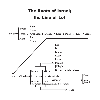A Watershed Event
In verse 10 of Genesis 11, a genealogy of Abram and Lot begins, starting just two years after the Noahic flood when Shem was 100. He became the father of Arphaxad who fathered Shelah who fathered Eber.
Eber is the root word of “Hebrew.” Eber fathered Peleg, a word meaning “division,” probably signifying the time of Babel. Peleg fathered Reu, who fathered Serug, who fathered Nahor, the father of Terah, Abraham’s “abba.”
Have you ever wondered about your roots? —not merely the nationality of your great, great, great grandparents, but what about your deep roots?
Many Bibles have a “Table of Nations” map that shows where the descendants of Noah’s sons, Shem, Ham and Japheth, migrated. Generally, Japheth’s went west and north toward the Europe of today; Ham’s went west and south to Canaan and Africa; Shem’s traveled south and east.
Perhaps you can surmise whether your roots are traced through Japheth, Ham, Shem, or all three. Ultimately, they descend to Noah and his wife, whose original ancestors were Adam and Eve. We are family.
Our brother, Lot, traced his roots to Shem. Lot was not an Israelite, but he was a Hebrew in a manner of speaking, since his great-great-great-great grandfather was Eber.
We learn from these verses that Eber’s sons had not traveled a great distance from the place of the division. They were in Ur which is believed to have been located near where the Euphrates and Tigris rivers come together, south of Babylon— where the fated tower had stood. Here, God called Abraham to go to a land he would show him.
By counting, we can see there are 10 generations between Shem and Abraham. As well, if we accept that there were only these, then Shem would have still been alive when Abraham was born.
Bible scholars are unsure whether or not some generations were left out when certain genealogies are given. In other words, there could have been more fathers and sons between Shem and Terah who are not mentioned. Moses, the author of Genesis, numbered 10 generations, perhaps as a way of setting forth God’s providential oversight of the development of history. In Scripture, 10 is the number of completeness. Following the Noahic flood, there elapsed a period of time that was complete. The birth of Abraham marked a watershed event.
The Line of Lot
After clicking on the image to view a larger version, click on your browser "back" button to return to this page.
